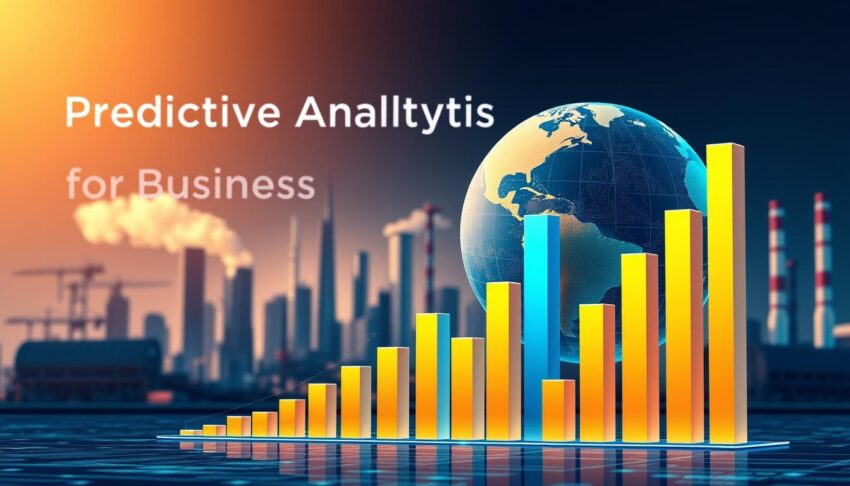How can businesses unlock hidden potential and drive growth by using their historical data? In today's world, data analysis is key. Predictive analytics is a game-changer for companies wanting to predict trends and make smart choices.
By using special algorithms and artificial intelligence, businesses can stay ahead. They can guess what customers want and how they will act. Using predictive analytics is not just a trend. It's a must for growing your business and making customers happy.
Key Takeaways
- Predictive analytics uses past data to guess what will happen next.
- Special algorithms and machine learning are important for making predictions.
- Companies can get ahead by knowing what customers will do.
- Using predictive analytics well can cut costs and make things more efficient.
- Adding predictive analytics to your business plan is key for growth.
Understanding Predictive Analytics
Predictive analytics helps organizations use data well. It finds important insights in data to guess what will happen next. It's used in many fields like finance, marketing, and healthcare.
It makes decisions better and work more smoothly.
Definition and Importance
Predictive analytics uses past data to guess the future. It's more than just numbers; it's a key tool for smart choices. It helps businesses know what customers want, making them happier and more loyal.
Key Components of Predictive Analytics
Good predictive analytics needs a few things. First, you need to gather data. Then, you analyze it. Finding patterns in big data is also important.
By using these steps, companies can make better guesses and get important insights.
How Predictive Analytics Drives Business Insights
Predictive analytics is a strong tool for businesses. It helps find important patterns in data. This leads to better decisions and happier customers.
Identifying Trends and Patterns
Predictive analytics uses smart algorithms to find trends. For instance, a big store can guess what people will buy next. This helps them plan better and sell more.
Enhancing Decision-Making Processes
Predictive analytics makes decisions smarter. Companies use past data to plan for the future. Amazon uses it to work better and find the best customers.
Improving Customer Experience
Predictive analytics makes customers happier. It helps businesses know what customers want. This way, they can offer things that customers like.

Predictive Modeling Techniques
Predictive modeling is key in business analytics. It helps companies guess what will happen next by looking at data. Knowing the different types of predictive models is important for good guesses. Each model works well in different ways, so picking the right one is crucial.
Types of Predictive Models
Companies use many types of predictive models. Each one is for a special purpose. Here are a few:
- Regression Analysis: Helps find how things are related and guess what will happen next based on data.
- Decision Trees: Shows choices and what might happen next, helping make decisions.
- Neural Networks: Works like the brain, looking at lots of data to find patterns and guess what will happen.
These models use different ways to help businesses. They meet different needs and situations.
Choosing the Right Model for Your Business
Choosing the right predictive model is key for success. What you choose depends on:
- The data you have
- What you want to achieve
- How accurate you need your guesses to be
Using the right model makes business analytics better. It leads to better guesses and easier decision-making. By matching the model to your business goals, you can grow and work more efficiently.
The Role of Machine Learning in Predictive Analytics
Machine learning is key in predictive analytics. It uses algorithms that get better with more data. This helps organizations analyze data better.
It makes forecasting better. It also helps understand customer behaviors and trends.
Machine Learning Basics
Machine learning is a part of artificial intelligence. It creates models that learn from data. These models find patterns in big data sets.
This gives businesses useful insights. Machine learning in predictive analytics is used in many industries.
Integration of Machine Learning in Data Analysis
Adding machine learning to data analysis changes how businesses see data. It uses advanced algorithms to automate analysis. This lets businesses quickly respond to market changes.
This makes a culture based on data. It leads to better decisions and staying ahead in the market.
Data Mining and Predictive Analytics
Data mining is key in predictive analytics. It helps businesses find important insights in big data. Knowing how data mining and predictive insights work together is vital for better decision-making.
By using good data mining methods, companies can turn raw data into useful knowledge.
The Relationship Between Data Mining and Predictive Insights
Data mining and predictive analytics work together to predict future trends. Techniques like clustering and anomaly detection help find patterns. This helps companies make smart plans.
Techniques for Effective Data Mining
Good data mining needs different techniques. Here are a few:
- Clustering: Groups similar data points together, allowing for nuanced analysis of certain demographics or behaviors.
- Association Rule Mining: Discovers relationships between variables, which can be particularly useful in understanding customer purchasing behaviors.
- Anomaly Detection: Identifies outliers within datasets, helping organizations pinpoint irregular patterns that could signify fraud or errors.
| Data Mining Technique | Description | Use Case |
|---|---|---|
| Clustering | Groups data into clusters based on similarity | Market segmentation analysis |
| Association Rule Mining | Finds rules that highlight relationships within the data | Recommendation systems |
| Anomaly Detection | Identifies unusual patterns in data | Fraud detection in financial transactions |

Forecasting with Predictive Algorithms
Forecasting is key in predictive analytics. It helps businesses see what's coming next. Predictive algorithms help us look at past data to guess future changes.
This knowledge helps companies make better choices. It also makes their operations run smoother.
Understanding Forecasting Methods
There are many forecasting methods. They all use predictive algorithms. Here are a few:
- Time Series Analysis: This looks at data collected at regular times. It finds trends and patterns.
- Exponential Smoothing: This method gives more weight to recent data. It's good for data with trends or seasons.
- Causal Modeling: This checks how variables affect each other. It predicts outcomes based on these relationships.
Real-World Applications of Forecasting
Forecasting is used in many ways. It helps many industries work better. Here are some examples:
| Industry | Application | Outcome |
|---|---|---|
| Retail | Inventory Management | Less stock-outs and better inventory levels. |
| Finance | Financial Forecasting | Better risk management and investment plans. |
| Healthcare | Disease Outbreak Prediction | Better use of resources and response to outbreaks. |
| Manufacturing | Supply Chain Management | More efficient operations and lower costs. |
Big companies like Amazon and Walmart use these methods. They stay on top of market needs. This helps them do better overall.
Building a Predictive Analytics Strategy
Creating a good predictive analytics strategy needs careful planning. You must define your business goals, collect the right data, and build strong models. Each step is key to using predictive analytics well.
Steps to Implement Predictive Analytics
First, understand your business goals. This helps you focus on specific problems or opportunities. Important steps include:
- Defining Objectives: Know what you want to achieve, like better customer service or more efficient operations.
- Data Collection: Get the right data from different places, making sure it's good quality for accurate predictions.
- Model Selection and Development: Pick the best predictive models for your data and goals.
- Testing and Validation: Keep testing models with new data to check how well they work and make changes as needed.
Measuring Success and ROI
It's important to measure ROI from predictive analytics. Companies should set KPIs that match their goals. Ways to measure ROI include:
| KPI | Definition | Measurement Technique |
|---|---|---|
| Cost Savings | Less money spent because of predictive insights | Compare expenses year to year |
| Revenue Growth | More sales from better marketing | Look at sales before and after using analytics |
| Customer Retention Rate | How many customers stay over time | Check customer loss each month |
| Decision-Making Speed | How fast you make decisions with data | Compare how long decisions took before and after using analytics |
Challenges in Predictive Analytics
Predictive analytics gives us great insights but faces many challenges. These include data quality and ethical issues with how data is used. It's key to tackle these problems to fully use predictive analytics.
Data Quality and Availability Issues
Data quality is very important for predictive analytics to work well. Bad data can lead to wrong predictions, which can mess up decisions. Companies need strong data rules to keep their data good and right.
Not having data when you need it is another big problem. Good data management helps get better data, leading to better results and more trust.
Privacy and Ethical Considerations
Privacy and ethics are also big issues in predictive analytics. Companies must deal with privacy laws and what people want with their data. People are getting more worried about their privacy, making companies think hard about how they use data.
It's very important to have clear rules for using data ethically. This keeps people's trust and follows the law. When using predictive models, focusing on data ethics is key to avoid using sensitive info wrongly.
Conclusion
Predictive analytics is changing how businesses grow and work better. It uses data in new ways, like machine learning. This helps companies stay ahead by making smart choices.
It makes customer service and work flow better. This is because it finds patterns and helps make decisions.
Using predictive analytics wisely is key. It has many benefits, but there are also challenges. These include keeping data good, respecting privacy, and being ethical.
By solving these problems, companies can use predictive analytics well. This leads to better plans and growth that lasts.
Adding predictive analytics to business is not just a trend. It's a must for success in the future. As more businesses see its value, using these insights will keep changing business today.
